Acroyoga

Acroyoga (also written Acro-Yoga or AcroYoga) is a physical practice which combines yoga and acrobatics.[1]
There are now many schools of AcroYoga. The original two schools were Acroyoga Montreal and Acroyoga Inc.. Acroyoga Montreal was founded by Jessie Goldberg and Eugene Poku in 1999 combining acrobatics, yoga and dance.[2] Acroyoga Inc., began in San Francisco in 2006, founded by Jason Nemer and Jenny Klein. This practice blends acrobatics, yoga and healing arts.[3] Both schools offer teaching certifications, and despite some differences have many similar poses while using gravity to promote strengthening and stretching.[4][5]
AcroYoga may provide physical and mental health benefits. In addition to the exercise and strength building aspects of AcroYoga the partner balancing can improve concentration and the massage elements can provide stress relief.[6] However Acroyoga is more vigorous than many traditional yoga practices and this may lead to more injuries.[7]
Roles
There are three primary roles in an Acro-yoga practice: base, flyer, and spotter.[8]
- Base - this is the individual who has the most points of contact with the ground. Often this person is lying on the ground with the entire back torso in full contact. This enables both the arms and legs to be "bone-stacked" for maximum stability and support of the Flyer. Main points of contact with the flyer are the feet (generally placed on the Flyer's hips, groin or lower abdomen) and the hands (which either form handholds or grasp the shoulders).
- Flyer - this is the individual who is elevated off the ground by the Base. The Flyer can move into a series of dynamic positions, and generally lets gravity do the work for them. A Flyer needs balance, confidence, and core strength.
- Spotter - this is the individual who has an objective view of the partners, and whose entire focus is on making sure that the Flyer lands safely in case of any slips. The spotter can also make recommendations to the Base and Flyer to improve their form.
Elements
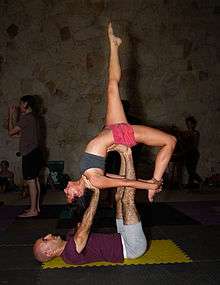
Acrobatics is the physical part of Acroyoga that uses gymnastics techniques to build strength, flexibility, trust and teamwork between partners. This is called Solar Acrobatic Practice by the California school.[9] Front plank is a basic Acroyoga pose where one partner (base) supports the flying partner above them with their hands and feet.[10]
Yoga reflects the physical, mental, and spiritual disciplines of traditional Yoga. This is called Yoga Practice by the California school.[9]
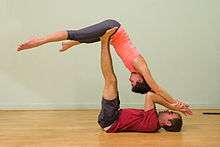
Therapeutics includes massage, therapeutic flying and partner yoga. The California school teaches Thai massage and inversion massage with their Lunar Healing Arts Practice.[9] The Montreal school differs from the California school in this area as they teach restorative and yin yoga.[11] A basic therapeutic pose is Folded Leaf in which one partner is inverted and supported on the vertical legs of the other partner whose hands are then free for back massage.[12]
Learning Acroyoga requires strength training, flexibility training and technique training.[13] Strength training is accomplished through repetition of exercises like push-ups and hand walking. Flexibility training is best done at the end of a session with a partner. Learning good Acroyoga technique takes time and effort and is best learned with an expert teacher.[13] One important Acroyoga technique is called stacking the bones. This involves the base partner keeping arms and legs straight to maximize the weight load on bones rather than muscles to support the flyer.[14]
Controversy
In late 2006, AcroYoga Inc. trademarked the word "ACROYOGA" and asserted that the word's first use anywhere was in 2005.[15] However the term had been used since 1999 by Jessie Goldberg and Eugene Poku[16] and their domain, acroyoga.com had been registered since 2005.[17] By way of example only, and not as a limitation, "AcroYoga" and the AcroYoga logo are registered trademarks of AcroYoga, Inc., under the applicable laws of the United States and/or other countries.[18]
Learning AcroYoga
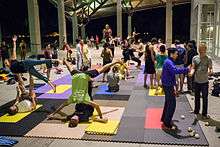
Yoga studios may provide instructor led AcroYoga lessons. Both the American and Canadian schools provide teacher training.
A typical Acroyoga session may include:[19]
- Circle ceremony promotes communication and openness
- Warm-up to gradually get your muscles ready for more strenuous exercise
- Partner flow - continue warming up with asanas and stretching with a partner[20]
- Inversions help build trust between the partners[20]
- Flying and acrobatics
- Thai Massage provides a chance for the flyer to become the giver and repay the base for their work
Some communities have regular AcroYoga Jams to provide a place for interested people to come together and practice. There are also larger AcroYoga events such as the annual Divine Play in Portland, Oregon that draw practitioners from a regional or national area.
Poses
There are many static acro yoga poses.[21] A series of acro yoga poses that are repeated in a continuous flow is called a Washing Machine.[22]
- Acro Yoga Poses
-
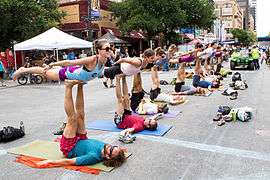
Front Bird - a basic acro yoga pose
-
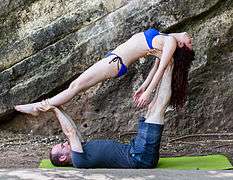
Whale
-

Hangle Dangle
-

Back Bird variation
-
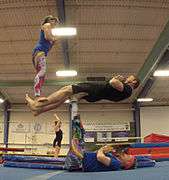
Three person balancing pose
-
.jpg)
Star - side view
-
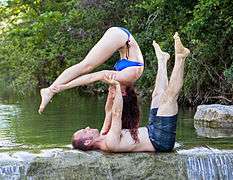
Floating Paschi
-
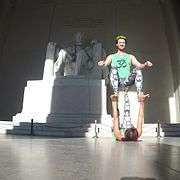
Throne Pose with base smaller than the flyer.
-

Non L-Basing pose
See also
References
- ↑ Ferretti, Andrea (June 2008). "Partners in Play". Yoga Journal. Retrieved 16 May 2008.
- ↑ "About Us". AcroYoga Montreal. Retrieved 29 April 2014.
- ↑ "The Practice: Three Main Elements". AcroYoga Inc. Retrieved 29 April 2014.
- ↑ Cowan, Claudia. "People are flipping for AcroYoga". Foxnews.com. Retrieved 5 April 2016.
- ↑ Shallow, Parvati. "AcroYoga: Better than couples therapy?". cbsnews.com. Retrieved 5 April 2016.
- ↑ Malone, Sam, AcroYoga: A New Form of Yoga, home-remedies-for-you.com, retrieved 2 February 2014
- ↑ Smith, Eva Norlyk (23 March 2013), The Yoga Injuries Debate: How 'Dangerous' Is Yoga, Really?, HuffPost Healthy Living, retrieved 2 February 2014
- ↑ Gates, Chee. "Extreme Yoga Poses and Positions". Fitness Magazine. Retrieved 29 April 2014.
- 1 2 3 "The AcroYoga Practice". AcroYoga.org. Retrieved 29 July 2014.
- ↑ "Front Plank". acropedia.org. Retrieved 29 July 2014.
- ↑ "FAQ". acroyogamontréal. Retrieved 29 July 2014.
- ↑ "Partners In Play". Yoga Journal. Retrieved 29 July 2014.
- 1 2 Nemer, Jason and Sauer-Klein, Jenny. AcroYoga Flight Manual, 2008, acroyoga.org
- ↑ "FIVE REASONS YOU SHOULD DO ACROYOGA". Pilgrimage of the Heart Yoga. Retrieved 29 July 2014.
- ↑ "AcroYoga". Legal Force Trademark Search. Retrieved 29 July 2014.
- ↑ "About Us". acroyogamontréal. Retrieved 29 July 2014.
- ↑ "Who Is Lookup". WhoIs.net. Retrieved 29 July 2014.
- ↑ "Copyright and Trademark Information". AcroYoga.org. Retrieved 3 July 2016.
- ↑ "AcroYoga". Kula Movement. Retrieved April 29, 2014.
- 1 2 Lee, Cyndi (November 2012). "Partner Up". Yoga Journal. Retrieved April 29, 2014.
- ↑ "Poses – Alphabetized". acropedia.org. Retrieved 29 July 2014.
- ↑ "Washing Machines – Alphabetized". acropedia.org. Retrieved 29 July 2014.
External links
- acromaps.com free resource to find groups, classes, and workshops across the globe
- Acropedia.org free resource for photos and video of many poses
- Acromuseum.com photo archive of acrobatic poses